ABLAZE
WHY Y2K FASHION IS HERE TO STAY

Y2K Revival Brings Back the Trend of Thin
ASK ABLAZE: College Dating Advice



Y2K Revival Brings Back the Trend of Thin
ASK ABLAZE: College Dating Advice

Take
quiz to find out if you have what it takes to be a successful entrepreneur!
Your ideal workspace would be:
A A sleek, minimalist office with the latest tech
B. A cozy home setup where you can think freely
C A vibrant coworking space buzzing with creativity
D Wherever your laptop and strong coffee can be found 2
When it comes to decision-making, you tend to:
A Carefully analyze all the data and options
B. Go with your gut instinct and see what happens
C Consult your network of mentors and advisors
D Flip a coin- spontaneity is your middle name
If you had a million dollars to invest, you would:

3
4
A Put it all in a diversified portfolio of stocks and bonds
B. Quit your job and start the business idea you’ve been dreaming about
C Donate a portion to a nonprofit you’re passionate about
D Treat yourself to a luxurious vacation, then figure out the rest later
Your ideal role model is:
A. Sara Blakely, the founder of Spanx
B Oprah Winfrey, a self-made media mogul
C Melinda French Gates, a philanthropic powerhouse
D Madam C J Walker, America’s first female self-made millionaire
When faced with a challenge, you:
5
B's:
C's:
A Make a meticulous plan to overcome it step-by-step
B Dive right in and improvise as you go
C. Seek out expert advice and guidance
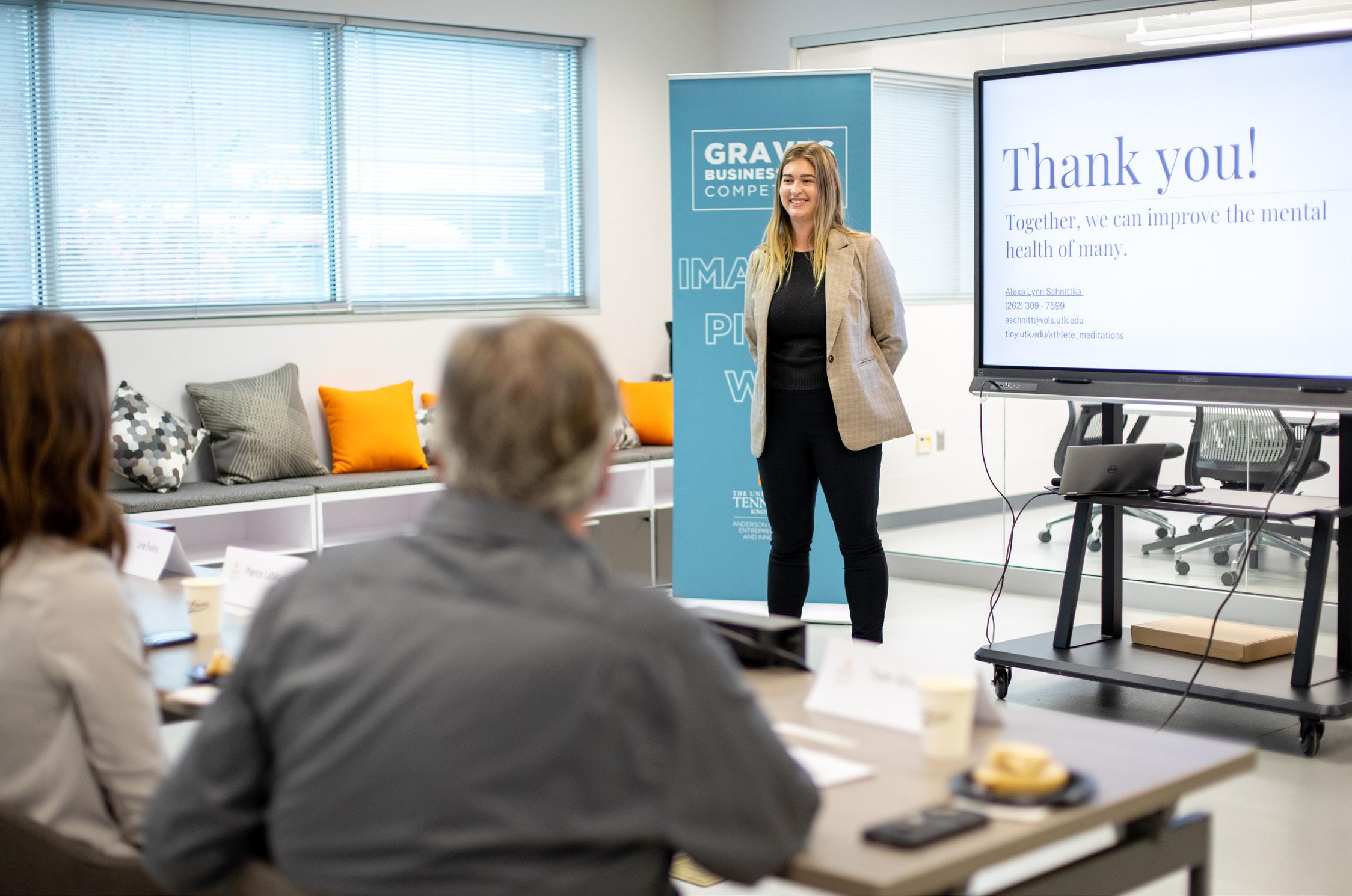
D Procrastinate a bit, then have a burst of creative problem-solving
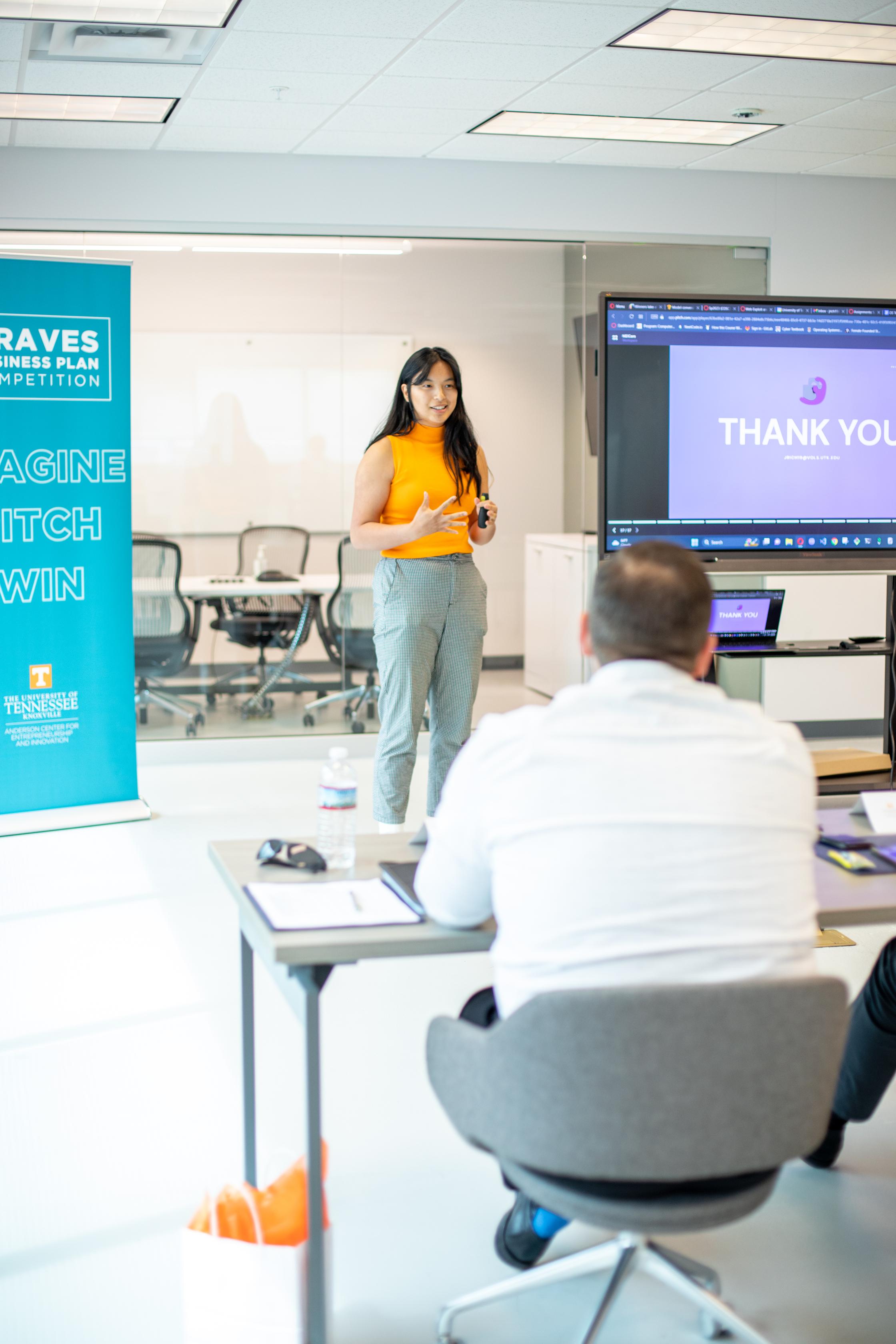


Y2K Revival Brings Back the Trend of Thin
What is it with the ever-present standard of the “perfect” body?
8

Defining a Modern Feminist

A look at the complexities and evolution of

Redlining DEI Worsens Inequality in
What the removal of DEI programs means for equality in the workplace.
Sticks up, Spirits High: Sports Leadership in the Women’s Field Hockey Team
As female athletes step into leadership roles, the women’s field hockey team illustrates the power of teamwork and friendship.
24
Knoxville: Now vs. Then
Painting a picture of what Knoxville was like in Y2K.
25
Spring Cleaning: for your space and for your mind
Advice for organization and mental wellbeing.
27
Why Y2K Fashion is Here to Stay
The return of styles and trends from an iconic era.
The Summer of Female Pop
How these four artists have brought pop music back to its prime.
From Musical.ly to Machine Learning
How modern technology has changed over the past 20 years.
29
Wait... What Month is it?
A look into the commemorative months of 2025
32
“Cover Your Drink!” The Dangerous Reality of Drink Spiking in college
Everything you need to know about drink spiking

Seeking Sisterhood
Finding genuine connections in college.
Earth Day, Every Day
Sustainability and Fast Fashion

Tips from fellow students about navigating relationships in college.
Designed by: Taylor Pearson
Models: Emma Fingeret, Taylor Pearson
Cover Photo: Sophia Carter
Cover Design: Lailah Rucker, Taylor
Pearson
Cover Model: Ava Hall
This magazine is produced by the students of Ablaze magazine and is not an

Dear Readers,
I am thrilled to share some remarkable highlights and updates from Ablaze magazine since the release of our third print edition in the Fall of 2024, and I hope you share our excitement over our recent accomplishments and vision for the future.
In the Fall of 2024, Ablaze magazine was awarded first place by the College Media Association in the Best Magazine News Page/Spread (Division I) category. This recognition is a testament to the hard work and dedication of our team. Thanks to the leadership of our departmental editors, our incredible staff has consistently delivered outstanding work with each new edition reflecting our ongoing growth and commitment to excellence.
This year, Ablaze is embracing the Y2K theme—not only out of love for the culture of that era but also to tap into a sense of nostalgia that resonates with us as college students. Our cover design, inspired by early 2000s teen magazines, is playful, vibrant and showcases our featured articles within the Y2K theme. This artistic choice reflects our organization’s creativity and the diverse topics we explore.
At Ablaze, we take pride in advocating for inclusion by offering a platform that celebrates students from all backgrounds. Originally founded in 2019 as a feminist magazine under the name Honey and rebranded in 2022 as Ablaze magazine, we remain committed to amplifying diverse voices and fostering a sense of belonging. Through each print edition, we aim to create a community where collaboration thrives among individuals with varied experiences and perspectives. Whether we’re spotlighting the newest women’s club team or redefining modern feminism, our stories reflect the richness of our shared humanity. At Ablaze, there’s a story for everyone.
We are immensely grateful for the support from our readers, advertisers, contributors and editors. Looking ahead, we are excited to continue growing and evolving with you. If you would like to support us and our mission, please scan the QR code below to donate. Your contribution will help us continue to create a place on campus where people can connect and find a publication that represents and resonates with them.
Sincerely,
Madelyn Stone Editor-in-Chief


























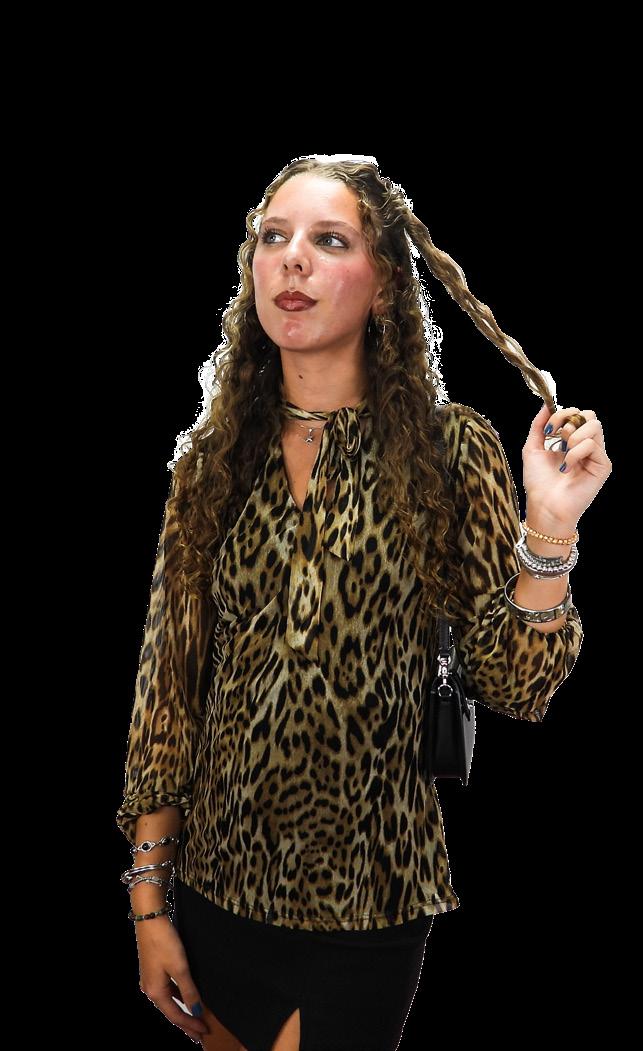






brings back the trend of
Written by Vandy Reddish | Photos by Amelia Beuscher | Designed by Arizona Reyes | Model: Madelyn Stone

The movement for thinness has had noticeable effects on society, especially young women who much of the media was targeted toward, according to women’s psychology researcher Shelly Grabe in the Psychological Bulletin in 2008.
“We’ve demonstrated that it doesn’t matter what the exposure is... If the image is appearance-focused and sends a clear message about a woman’s body as an object, then it’s going to affect women,” Grabe said.
Since the 2000s, disordered eating issues have increased among young women. Grabe’s studies report that more than 50% of young women state they are disappointed with their bodies.
According to Grabe, this is largely due to media messaging. Through extreme dieting and exercise methods, they are seeking to shrink their bodies in accordance with the doctrine of thinness.
With so much taboo around defining the true definition of an eating disorder, it can be hard to diagnose them. However, nutrition experts have noticed several health concerns indicating undereating and overexercising brought on by disordered habits.
The National Library of Medicine reports heart disease, cardiac abnormalities and bone thinning as just a few of several physical symptoms of eating disorders. Even at their most life threatening points, patients may still refuse to give up their habits.
Teens on TikTok and other short-form social media platforms are constantly exposed to content encouraging them to lose weight. Many are even responsible for some of it.
Eventually, we reach the question of why thinness is the beauty standard anyway. There is a constant demand to shrink oneself, even at the expense of one’s happiness and other goals. The body is a spectacle, now more interesting than the real human being.
Not everyone wants it to be this way. When she debuted for a second time in the September 2009 issue of Glamour

Magazine, model Lizzie Miller shot to fame for her representation of a “plus-size” female body.
In the magazine she sat cross legged with her head on her shoulder and her stomach rolling over her knee. Miller at the time was a size 12, an average-size for American women. However, when she was given her space in the modeling world, it made her feel like a spectacle.
“The fact that this picture caused such a frenzy…says that obviously, something that people need to see. I’m not obese, but I’m also not stick thin,”
Miller said in an interview with Good Morning America.
Miller was hailed by women who viewed her picture for her audacity. Hundreds of viewers raved about how her authenticity made them feel empowered. For women whose bodies would have been alien in the pages of a magazine, she was proof
that beauty was not equivalent with thinness.
In the midst of diet culture revial, some celebrities and social media influencers are trying to shift the focus. Rather than promoting the idealized thin figure, they are advocating for authenticity and healthier eating and fitness habits.
Influencers post videos unposed and at rest, displaying the full spectrum of shapes one body can take in a day. These videos are part of body positivity and body neutrality movements, which try to take a different perspective to body image than its extreme counterpart. Many videos stress the importance of the body to enable a person to live, not to be an obsession.
“I was so tired of feeling unworthy of feeling beautiful because of my size,” Instagram influencer Desiree Marcano told the online magazine, Obviously. “I knew there was more to life than always worrying about my weight and food. The truth is that not every day is perfect…Body positivity isn’t anti-health, it’s just not hating yourself and trying to be anything other than what you are.”
The perfect body type is an impossible standard to satisfy. “Perfect” is always changing, which means it is not truly perfect at all. Our bodies are meant to grow and change. If we are lucky enough, we will live to see our perfect skin sag and wrinkle. That represents something more powerful than the size on a pair of jeans.
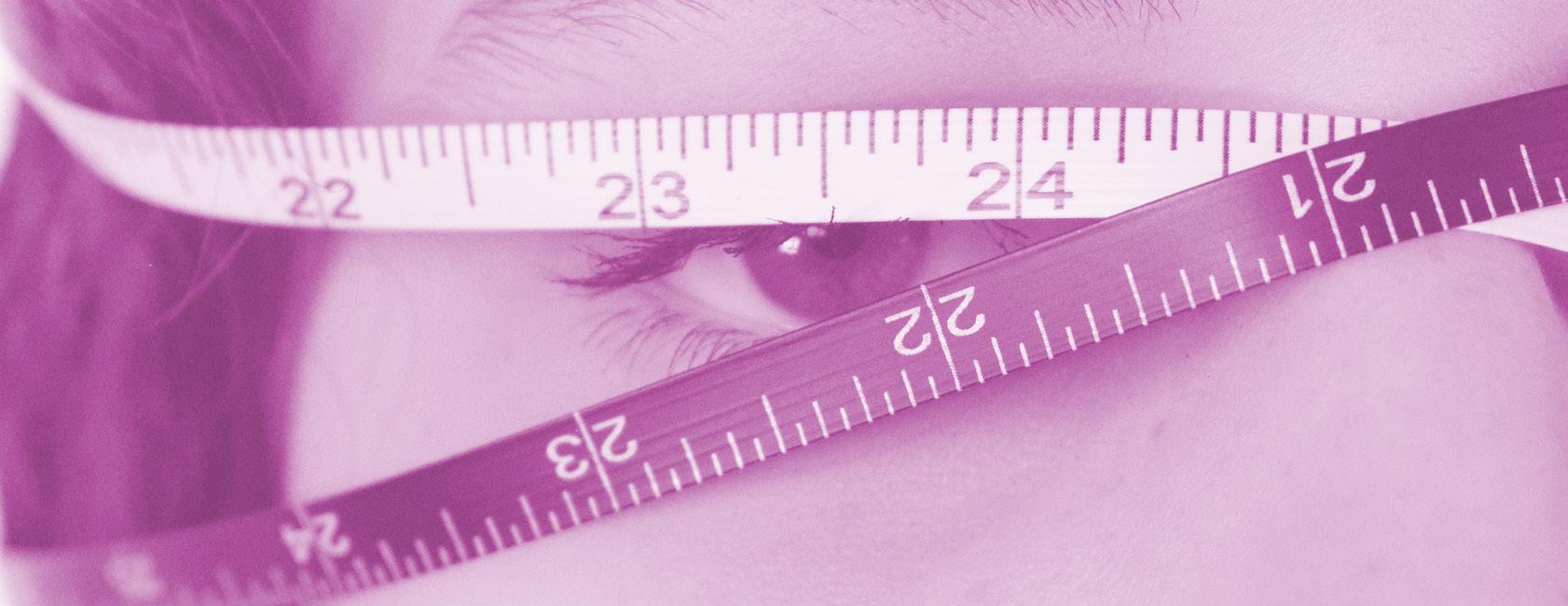
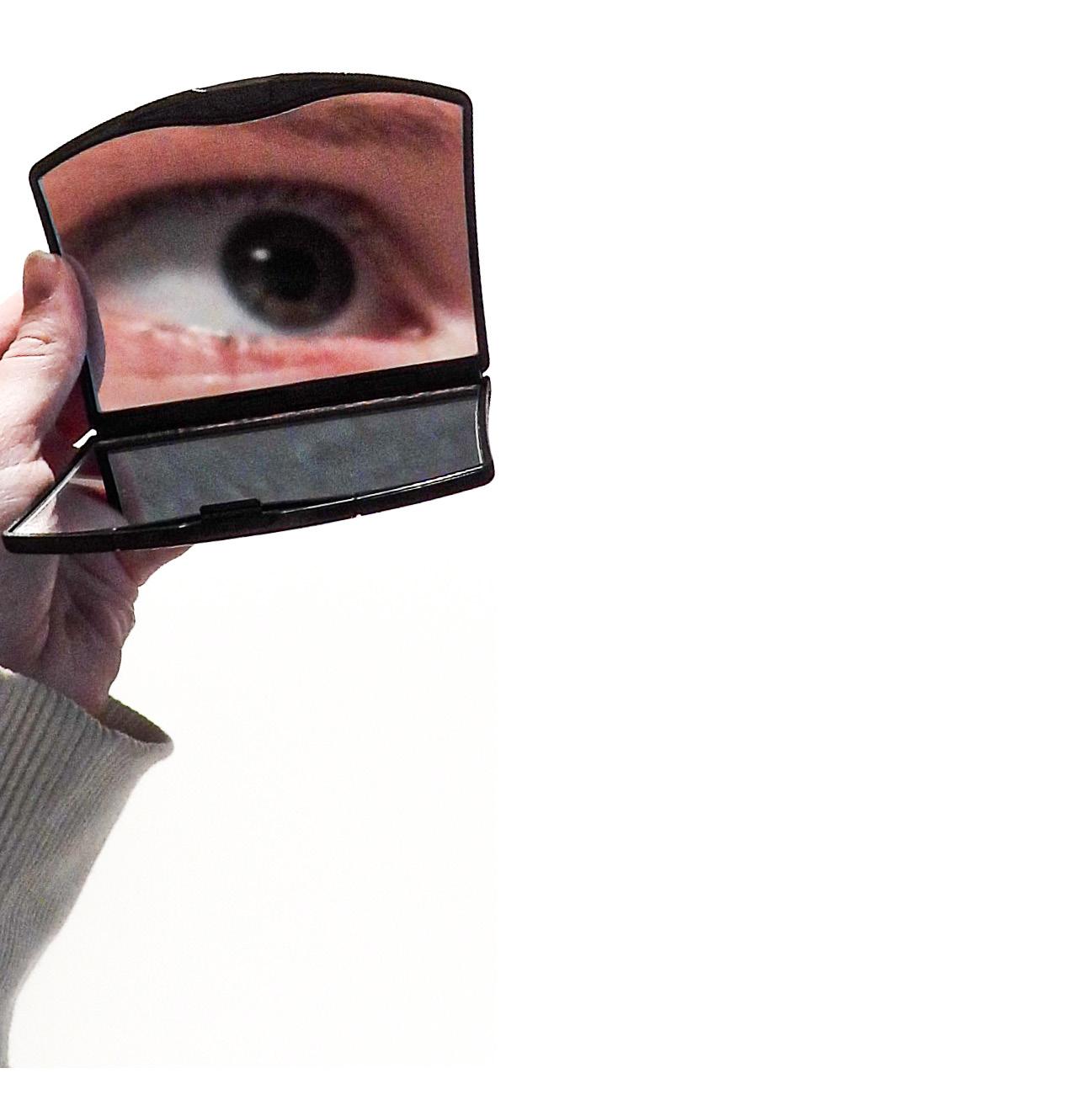

TWritten by Ella Kelley | Photos by Sophia Carter | Designed by Sydney Barney | Model: Parker Fleenor
he slew of laws and policies in the U.S. restricting women and marginalized groups that have emerged in recent years display a continuous and urgent need for feminism. Feminist activists see restrictions on reproductive healthcare, transgender healthcare and certain education topics as setbacks designed to further the patriarchy.
Despite this, 45% of Americans in a 2020 Pew Research Center survey said that feminism is polarizing and 30% said it was outdated.
It is necessary to unpack what exactly feminism is and where it came from in order to understand the current state and view of feminism in the modern era.
Feminist is a loaded term with a meaning that has evolved over time. The baseline definition of feminism is the belief in equality of all people regardless of gender or sex. According to the book on interdisciplinary feminist theory, “Theorizing Feminism”, most would agree that a feminist is “someone who holds that women suffer discrimination because of their sex, that they have specific needs which remain negated and unsatisfied, and that the satisfaction of those needs would require a radical change (some would say a revolution even) in the social, economic and political order.”
Anything beyond that is up for debate. The evolution of the word “feminist” has produced a variety of interpretations of the meaning of feminism.
The history of feminism is often studied through the lens of different “waves of feminism.” Though some scholars are moving away from this framing because it oversimplifies a nuanced history, it is still a valuable tool to understand the history of feminism. The waves of feminism are used to divide the history of feminism into several distinct periods of time.
The first wave of feminism began with the women’s suffrage movement in the mid-1800s. The early women’s rights movement was connected with abolitionism, but the passage of the 15th Amendment led to the exclusion of non-white women because many women’s rights leaders were angered that Black men were able to vote before they were.
The second wave of feminism, inspired by the civil rights movement and Vietnam War protests, was marked by a reevaluation of gender roles and a demand to end sexist discrimination. The third wave emerged in the 1990s, centered around issues of sexual harassment and a lack of women in positions in power. It also demonstrated a shift to focus on inclusivity and intersectionality.
But, what is feminism in the modern era? It depends on who you ask, according to Alexandra Chiasson, PhD and the associate director of UT’s Women, Gender and Sexualiy program.
“Some people would say that all being a feminist requires is that you believe that everyone is equal, regardless of sex. I think at this point, we also have a number of people who think that it’s more complex than that, that we should think about other categories of difference - identity categories where people are experiencing oppression as a result of those,” Chiasson said.
She explained that intersectionality, which originated from legal scholar Kimberlé Crenshaw, has become a term familiar to people outside of the academy as a focus of modern feminism.
Intersectionality describes how the intersection of different identity categories creates unique instances of discrimination and oppression. It was originally used in the field of employment law but has since been extended to apply to social issues more broadly.
The present movement in feminism, which some argue is in its fourth wave, centers around intersectionality - focusing on people who have been historically excluded from mainstream feminist movements, like women of color and gender non-conforming people.
Feminism has historically been a political identity around which people organize movements. However, as the term has become more widely accepted, it has lost some of its power.

We have to think of feminism as something more than getting a bunch of people to say, ‘I’m a feminist.’ And instead, get people to think about, what does that word mean, really?

“We have to think of feminism as something more than getting a bunch of people to say, ‘I’m a feminist.’ And instead, get people to think about, what does that word mean, really? And, if we’re really going to make the world a better place, what responsibilities do we have, especially if we are applying that label to ourselves?” Chiasson said.
According to Chiasson, feminism has become a less organized po litical movement, largely due to social media. From her perspective, the most predominant form of feminism now is “TikTok feminism.”
“It’s sort of like the feminist issues of the day are decided by what’s going viral at that moment in time, whereas in the past, there’s been a lot of work to connect people and to organize. In some ways, it creates and strengthens political movements, but now people already feel connected because of the internet, so they don’t see the ways they are actually quite disconnected from each other,” Chiasson said.
Chiasson explained that political movements suffer because people feel that having a political view is enough and there is no need to organize around it. However, Chiasson believes that the exception to this lack of contemporary feminist organization is around the fall of Roe v. Wade.
“I think that reproductive freedoms and reproductive justice in some circles has become a rallying point and strategy to actually engage people politically, get people out to vote and people who have the means to donate to organizing causes, to kind of change the political scene around reproductive health, which has become so dire without access to legal abortion in so many states,” Chiasson said.
Chiasson explained that one of the most important ways to understand how feminism has evolved is to have intergenerational conversations. She advises students to speak with their parents, grandparents or elders in their communities. In order to understand feminism on a broader level, it is important to look at how it has evolved in local, personal contexts.
“I think that when we talk about feminist history, it makes sense to start locally, especially if the goal is to make political change happen,” Chiasson said.
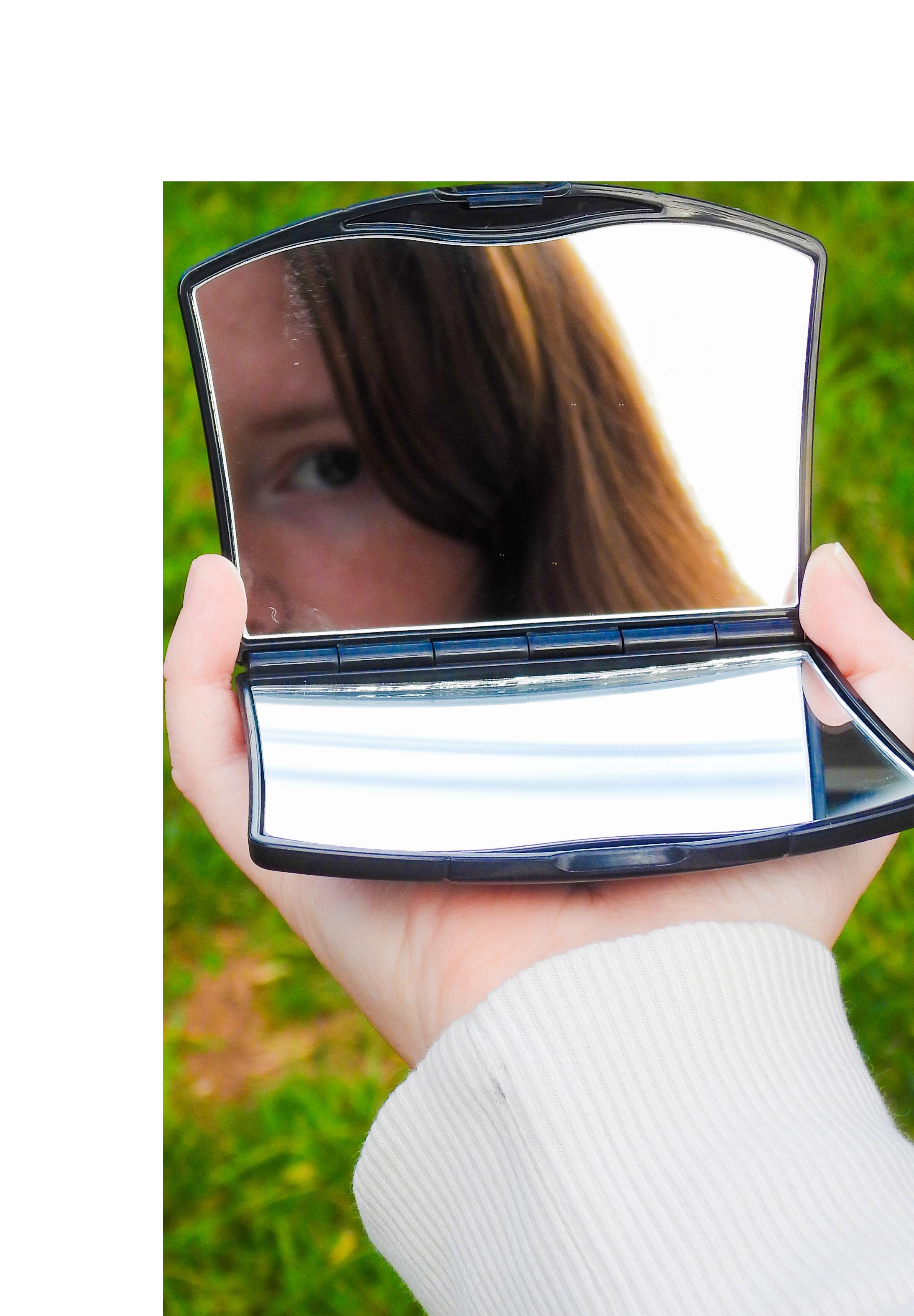
Though feminism has evolved over time, the movement remains important in the fight to protect women and marginalized groups, locally and across the world.


In the 2000s, corporate America embraced Diversity, Equity and Inclusion (DEI) programs as essential for creating more equitable workplaces. These initiatives aimed to break down barriers for underrepresented groups, fostering an environment where talent could thrive regardless of gender, race or background.
Fast forward to 2025, and the nation finds itself in renewed debate over these issues. Despite decades of progress, DEI programs are now at the center of a political and cultural backlash, with some labeling them as “too woke” for America. Recent legislation is reshaping the landscape for DEI initiatives, as several states have enacted laws prohibiting public entities, state agencies and government-funded higher education institutions from implementing these programs. These restrictions are altering hiring practices and complicating the legal landscape for organizations that prioritize diversity, putting pressure on businesses to reconsider their DEI commitments.
In Tennessee, these challenges hit close to home. The University of Tennessee recently renamed its Division of Diversity and Engagement to the Division of Access and Engagement, reflecting a broader shift in higher education as institutions respond to legislative pressure. This anti-DEI sentiment is not confined to education; it is rapidly spreading to corporate America.
Companies like McKinsey, PwC and Disney have scaled back or eliminated DEI programs, citing the need to minimize legal risks and avoid political backlash. These motions mirror the culture wars of the 2000s, where discussions of systemic inequality sparked intense, polarizing debates.
The question remains: why is fostering equity still considered radical in a nation built on the principles of equal opportunity?
As legislative pressure mounts, the rollback of DEI programs is particularly devastating for women and minorities. These groups have long relied on such initiatives for fair access to leadership roles, mentorship opportunities and inclusive workplaces. Without these programs, the gap between opportunity and representation widens, undoing years of progress.
Lauren Cunningham, director of research for the Neel Corporate Governance Center and Haslam’s Keith Stanga Professor of Accounting at UT, offers a nuanced perspective on these changes.
“I do not view this change as entirely negative or positive. I love the word ‘access,’ which emphasizes the need to create open educational opportunities for all Tennesseans,” Cunningham said. “However, removing the word ‘diversity’ risks making individuals who identify as diverse feel invisible or overlooked.”
Cunningham emphasizes the importance of looking beyond surfacelevel changes.
“It’s not about checking boxes or meeting quotas. When we bring diverse viewpoints into a room, we can brainstorm better solutions to complex problems. It’s about genuinely making a company a better place to work in and with,” she said.
In the face of legislative and corporate pullbacks, the focus should be on educating people about why diversity matters—not just as a moral imperative but as a business and cultural necessity. Equity is not a “radical” idea but a fundamental part of a fair, functioning and progressive society.
“We are training future decision-makers. We need people who promote inclusivity.” She advocates for a holistic approach to diversity and inclusion, suggesting that when companies genuinely embrace the challenge to improve themselves, diversity naturally follows,” Cunningham said.
According to McKinsey’s 2024 Women in the Workplace report, achieving gender parity in leadership remains a distant goal. For white women, it could take about 22 years to reach parity in leadership roles, while women of color face an even steeper climb, needing more than 48 years to achieve equal representation in senior leadership.
Organizations must not only defend the gains made but also proactively develop leadership pipelines for women and minorities address promotion gaps and hold themselves accountable for equitable advancement.
“Small actions can have huge impacts. Encourage a company to take a step back and consider how diverse viewpoints would impact their success,” Cunningham said.
While the current climate poses significant challenges to DEI initiatives, the path forward lies in emphasizing the tangible benefits of diverse perspectives in problem-solving and decision-making. By focusing on creating genuinely inclusive environments and valuing diverse viewpoints, organizations can continue to make progress even in the face of legislative obstacles.



Cheetah print has taken over the Pinterest girlies. Tiny, ultramini skirts and low-rise jeans are everywhere you look. Belly chains and small, baguette-style bags trending on TikTok. Yes, the return of Y2K fashion is in full force.
In today’s fashion, 2000s and Y2K trends have been prevalent in what is deemed as the current “it girl” or “must have” trend.
But what exactly is Y2K? That term gets thrown around a lot but the definition is still a little blurry. It is generally known as an abbreviation for the year 2000 but has now become a well-known term with fashion from that time period.
“Y2K fashion is all about making a statement and making it louder than anyone else,” Nav Gill wrote for online fashion magazine, Editorialist.
Some of the most trending items brought back to life are low rise jeans, baby tees, fur, and purses. The low rise jean, while maybe not as low as it was in the 2000s, has returned with brands like Mui Mui and Diesel rebranding the low rise


jean for the current demographic.
Influencers and television shows like “Euphoria” have also highlighted the Y2K vibe and thus popular brands have supported the trends. Celebrities like Charli XCX, Addison Rae and Billie Eilish have leaned heavily into the Y2K fashion style and created a revamped version of what was popular.
Celebrities have always paved the way for fashionable clothing styles and popular trends. During the 2000s, the early age of social media, technologyfocused super heavily on what these pop culture celebs were wearing and how they were participating in the trend cycle.

Similarly today, influencers are the main way that we get our fashion inspo and with the current pull towards Y2K fashion in pop culture, we also see those pieces in our day-to-day lifestyles.
Apps like Pinterest, TikTok and Instagram have allowed for the Y2K






Thrifting has become a common way for people to buy clothes, especially those looking for a style like Y2K or older fashion pieces. Plus, thrifting is a convenient and cheap way to bring in new styles to try out and mix up the day-to-day look.
As well as resale apps such as Poshmark and Depop that thrive off of selling vintage and second-hand clothing, it’s easy to search for certain styles, such as Y2K, and find those unique and trending pieces.
“I get most of my clothes by thrifting. I think it’s a sustainable way to shop these current fashion trends,” Salazar said.
Salazar also said that while she might not dress in full Y2K, she loves it when people do their own thing in regards to fashion and express themselves by what they like, which was the main goal of the Y2K style– to make a statement and be different.
Fashion is all about expressing yourself and feeling confident in what you wear. The Y2K aesthetic fully embraces that concept and pushes the boundaries for what is fashionable. It’s a great message to spread through being yourself and expressing who you are. That’s the best trend you could follow.

Written by Audrey Holland | Illustration by Joe Mitchell | Designed by Emma Fingeret
Over the last few years, pop music has been pushed into the background. Nothing new or refreshing was engaging listeners into keeping up with the genre.
But everything changed this past summer. Four talented, female artists came out with massive albums that dramatically changed the way audiences view the style of pop and women empowerment in music. These women are Charli XCX, Sabrina Carpenter, Billie Eilish and Chappell Roan.
The British pop star, Charli XCX, blew the world away with her recent album “BRAT.”
redefine their femininity and reclaim the identity of being a brat.”
Another UT student, Ally McNabb, adds to this, saying it’s a “fun, sexy energy.”
Charli XCX has brought a captivating, killer vibe to pop music. She has created a space that anyone can be a part of. She ditches perfectionism and experiments with the tones and beats that empower her and other women, creating a fun and carefree environment for them to let go. Her mindset that women can be sexy and spellbinding all the time is what has made her such an icon.
Carpenter’s confidence and uprising have continued to inspire fans to go for their dreams. She has developed her brand in a way that makes her recognizable, such as her Marilyn Monroe-like hair and her vintage tour theme. From Disney actress to record breaking singer, Carpenter has shown that she can be whoever she wants to be.
Adding to the female pop albums of the summer, “HIT ME HARD AND SOFT” brought Eilish’s authenticity and personal life into play. This album has shown off the evolution of her artistic style and identity with diverse songs, lyrics, sounds, phenomenal production and a sort of eeriness and haunting. Eilish has opened up more about her personal life in the album, such as relationships and friendships, being in touch with her sexuality and even her experience with stalkers.
How these four artists have brought pop music back to its prime

“She is true to herself. She isn’t hiding,” McNabb said.
Eilish is creating music and sounds that she finds beautiful, continuing to push and embrace this modern motion of female pop.
“Billie Eilish is always redefining what pop music looks like,” Mwaura said. “She doesn’t let the industry determine her style and
She has created a new image of what it means to be a famous artist, but not look like the standard pop icon. By embracing her baggy style, she is breaking stereotypes that audiences hold about how female pop stars look and act, allowing other women to feel that they don’t have to adhere to what society expects of them.


Just like these other female artists, Roan has been crushing records with her album “The Rise and Fall of a Midwestern Princess.”
Even though the album was released in September of 2023, Roan has gained a massive fanbase over the summer with her single “Good Luck, Babe!” The artist is well liked due to her unfiltered attitude and drag inspired style.
While Roan is very positive and upbeat, she also touches on the idea of figuring out life as a woman in her twenties. Her theatrical and performance heavy music have drawn the eyes of many audiences, as well as her strong
themes of sexuality and being a girlboss in her songs. She has shown fans that they can continue to be true in their self expression and that we are all human.
“She helps us see that we’re grown, but we can still have crushes and mess around like we’re kids,” McNabb said. “Her music is about not reverting to who you were, but understanding who you were.”
Roan has brought a refreshing mindset to the music industry, challenging cultural norms, elevating the platforms of artists of color who deserve more attention and spreading the message of being true to yourself. With her popularity rising during Pride Month in June, Roan’s unapologetic approach to individuality has uplifted many fans to be comfortable in their sexuality.
“She refuses to be a persona,” Mwaura said. “She demands respect.”
Each of these artists are unique, special and empowering in their own way. And yet, they each inspire other women to be comfortable in themselves and proud of their self




your Drink!' “COVER your Drink!”
Written
For young adults aged 18-22, college is a first taste of total freedom, and that freedom can be taken to the extreme. Frat parties and bars on the weekends have become a college norm. While this routine may sound appealing, students should stay educated and safe when going out. A 2016 study from the University of South Carolina found that nearly 8% of college students had reported an incident where they had been drugged. Furthermore, 65% of victims of drugged drinks expressed that they were unsure of the appropriate course of action to take after being spiked, according to a 2023 study conducted by LAD Bible Group.
In the media, being “roofied” is often portrayed as a person taking a drink and immediately blacking out, losing all of their stability and memory. While this reaction is plausible, it is important to understand that there is a wide variety of date-rape drugs and endless possibilities of unique reaction to these drugs. According to the Better Health Channel, some of the lesser known side effects include feeling “out of it” or more intoxicated than you should be based on your alcohol intake, speech difficulties such as slurring speech, loss of inhibitions, nausea, vomiting and breathing problems.
Now what do I do?
If you believe you have been “roofied,” trust your gut. You don’t have to play detective to defend or prove what you experienced. Should you start to feel symptoms, the first step is to alert someone you trust. This person doesn’t have to be a close friend, it can also be a bartender, a security guard, or the host of the party. After alerting someone of your situation, find a safe place to rest and recover. The last step is to talk about your experience, either with your chosen trusted person or with a support system such as a counselor.
Aside from the physical effects, someone who has been spiked may also experience a range of emotions and struggle with their mental state. According to the Metropolitan Police Department, common emotions include shock, denial, anger, guilt, frustration, anxiety and depression. You may not want to face these emotions, but finding a trusted person with whom to express them can assist in the recovery process.
There are also many options for on-campus counseling. On the counseling center website, you can schedule appointments for group therapy, shortterm counseling, single intervention, and/or psychiatry services.

When someone confides in you that they have been drugged the most important thing is to believe and listen to them. Having someone to lean on physically and emotionally can prevent the “roofied” individual from being persuaded into actions they don’t want and from being surrounded by the wrong people. Additionally, it is important to keep a close watch on their physical state, as some date rape drugs can lead to loss of consciousness, muscle spasms or seizures.
If they begin to show signs of physical harm or start to lose consciousness, you should contact an emergency health service for advice on what action to take. The student health center on campus has a 24-hour nurse advice line that connects you to a registered nurse to relay your concerns to and receive guidance from. To contact the nurse advice line call (865) 974-5080. If the situation elevates or the nurse advice line is unable to assist you, call 911 immediately.

...meaning don’t let someone be a victim in fear of speaking out.
“If you see somebody tamper with somebody’s drink or any kind of substance, speak up. Be that person,” said Jennifer Simmons Kaleba, Vice President of Communications at RAINN, an anti-sexual assault organization.
People tend to focus on protecting their alcoholic drinks, but any beverage and even food can also be spiked, and should always remain under your watch. Not only should you watch your drink, but also watch out for your friends. When out at any party or a bar, it is best to stay close to your friends, or stay updated on each other’s locations at all times.
If you or someone you know has been a victim of “roofie” drugs, the most important thing to remember is that it is not your fault, ever.

Scan this QR code




Written by Emma Kate Murphy | Photos by Maywyn Hayamack | Designed by Taylor Pearson
The thought of moving to college can be overwhelming as you hug your hometown besties goodbye. Leaving friends who felt like sisters and the comforts of home behind can leave girls feeling lonely and isolated. Movies and TV shows depicting college make finding friends look easy with girls instantly connecting with their future bridesmaids in their dorm hall. However, many students struggle to find genuine relationships at first.

Luckily, there are numerous ways for women on campus to come together, build meaningful friendships and find a sisterhood. These connections can help make the University of Tennessee’s big campus feel small.
Finding sisterhood looks different for each girl. UT offers multiple opportunities to find the right fit for everyone.
When people think of sisterhood in college they may immediately think of sororities and Greek Life.
UT has three Greek Life councils where women on campus could find a sisterhood that is just right for them: Multicultural Greek Council (MGC), National Pan-Hellenic Council (NPHC) and Panhellenic Council.
MGC represents ethnically and culturally based sororities and fraternities. It promotes awareness of multicultural diversity and advocates for justice and equity. Its organizations have a cultural basis and focus on multicultural ideals and interests. The three MGC sororities at UT include Delta Phi Lambda Sorority, Inc., Lambda Theta Alpha Latin Sorority, Inc. and Sigma Sigma Rho Sorority, Inc.
NPHC is comprised of the “Divine 9” historically black sororities and fraternities. These organizations were founded during a time when African American women were denied the ability to join traditional sororities. They strive for unity and economic empowerment and work to foster cooperation between members. The four D9 sororities at UT are Alpha Kappa Alpha Sorority, Inc., Delta Sigma Theta Sorority, Inc., Sigma Gamma Rho Sorority, Inc. and Zeta Phi Beta Sorority, Inc.
power of women’s-only experiences and the importance of higher education for women. Panhellenic at UT has 14 sororities, including its newest addition, Alpha Gamma Delta, which welcomed its founding member class in the fall of 2024.
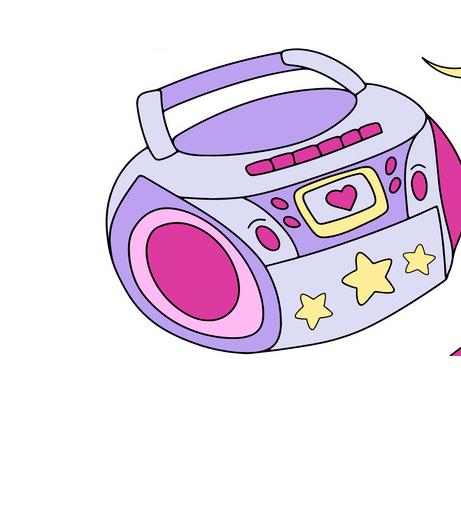
“Sisterhood means someone to hold you accountable and have each other’s backs,” said Siedah Buckley, president of NPHC and member of Delta Sigma Theta Sorority. “We know we want the best for each other and we know we can count on each other.”
“To me, sisterhood is a connection that just means more. It’s a bond that is created through shared experience and a love that stands the test of time. To have a sister is to have someone who you know you can go to for any situation in any circumstance. It’s someone you can trust – no matter what,” said Panhellenic president Bella Tepedino, a member of Delta Zeta.
People who are unfamiliar with the Greek organizations on campus may not realize how inviting and inclusive they can be.
“If you’re familiar with NPHC, you’d think there would be a lot more tension between our orgs because of how we were founded, but we’re all cool with each other,” Buckley said. “There’s no bad blood. We’re really open with people, so don’t be afraid to come up with us and talk with us. We’d love to talk to you!”
Tepedino added that the sororities focus on their values and work toward growth in the community.
“Something that might surprise people about the Panhellenic Sisterhood is how vast the connections span and how deep the history behind our chapters are,” she said. “Panhellenic sororities were all founded in the purpose for women to be able to gather and share information, ideas and experiences.”
Finding a sisterhood goes beyond each individual sorority within the Greek councils.
Panhellenic Council represents the women’s sororities recognized by the National Panhellenic Conference. It advocates for the

“I have friends in every single sorority here of the four in D9,” Buckley said. “There is definitely a sisterhood between all the




sororities. Anyone in the D9, we’re all connected and we all have each other’s best interests at heart.”
A sisterhood is more than a simple friendship. The women in sisterhoods are deliberate in building lasting relationships.

Buckley said. “That doesn’t have to be in a sorority, it could be a club… get involved as much as you can.”
“Support and intentionality [are] a priority for me when cultivating sisterhood across our community,” said Tepedino. “I try to show how much I care about our chapters and the women in them by listening and spending time with them! There are so many wonderful, impressive leaders in the Panhellenic community. It’s such an honor to work with them, let alone be friends with them.”
Sisterhood can also be found outside of Greek Life.
Tepedino agrees, “Get involved! Join a club or an organization. It seems scary until you go out and try it. Putting yourself out there and attempting to create a new experience for yourself is the bravest thing you can do, and it will pay off in one way or another. There are so many fantastic people here on Rocky Top; everywhere you go awaits another connection to be made!”
The VOLink website is a great way to search for organizations on campus. Joining one or more of the many clubs offered at UT is a great way to get involved on campus and build a sisterhood of like-minded people with similar interests.

UT offers over 400 student organizations, including many womenspecific organizations. Check out the student engagement fair at the beginning of each year to see and get a chance to talk to multiple organizations.
“Get in where you fit in. It’s really about getting involved, saying hi to people you meet and people in your class. I know that sounds daunting but that’s truly how you make your friends,”


Developing meaningful friendships and finding true “sisters” takes time. The first person you meet in college might not be the lifelong friend you dreamed of, but the friendships you eventually do find are so special and likely to last far beyond your college years. These sisters are reliable, support you in your lows, and make the highs of college even better.

It’s possible for every woman on campus to find a sisterhood here at UT whether within Greek Life or another campus organization. College is a fun and unique environment where you have opportunities to meet lifelong friends and sisters every day. It could be at a sorority event, a club meeting, someone in class or even the girl who lives down the hall.



Sports leadership in the women’s field hockey team
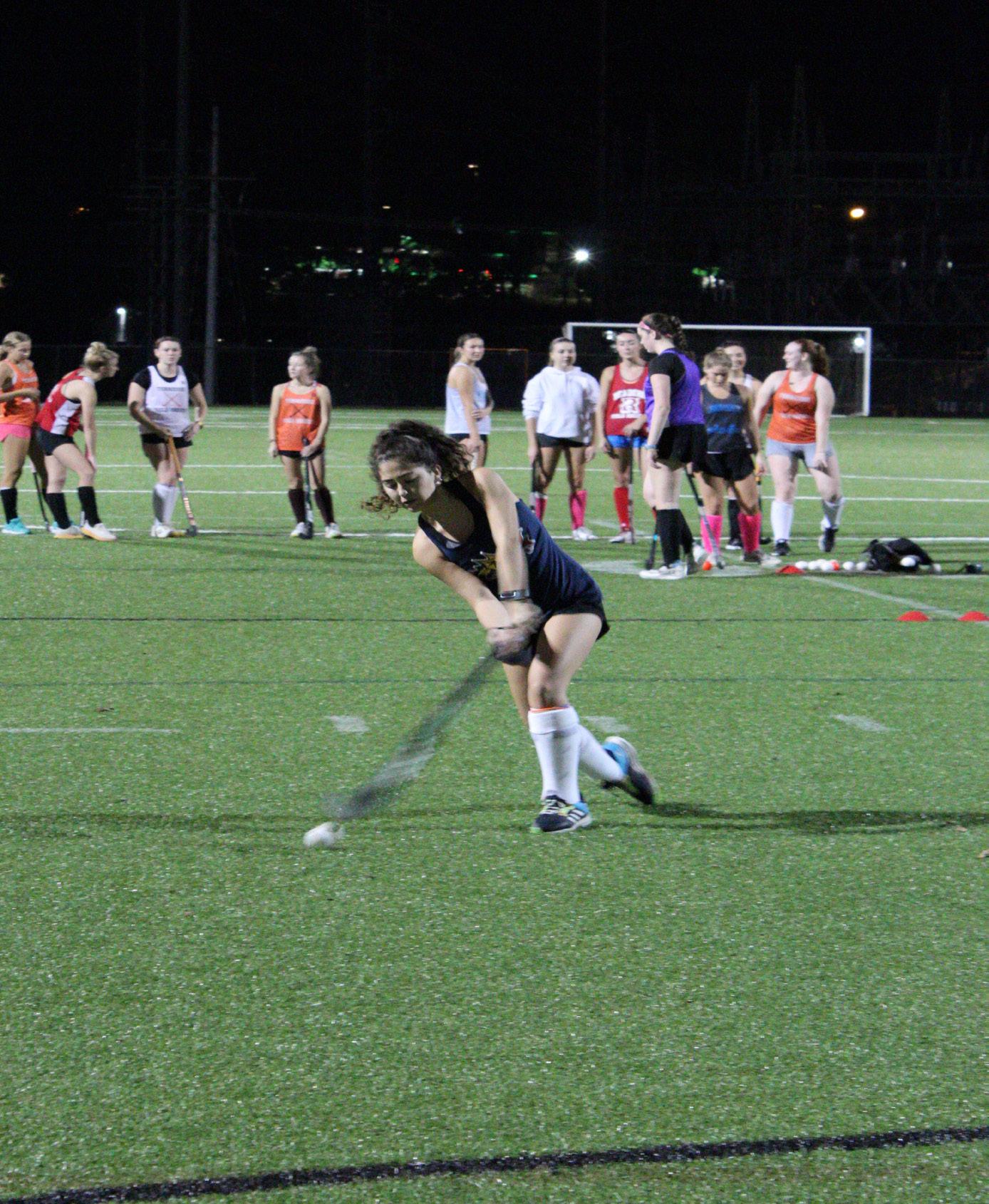

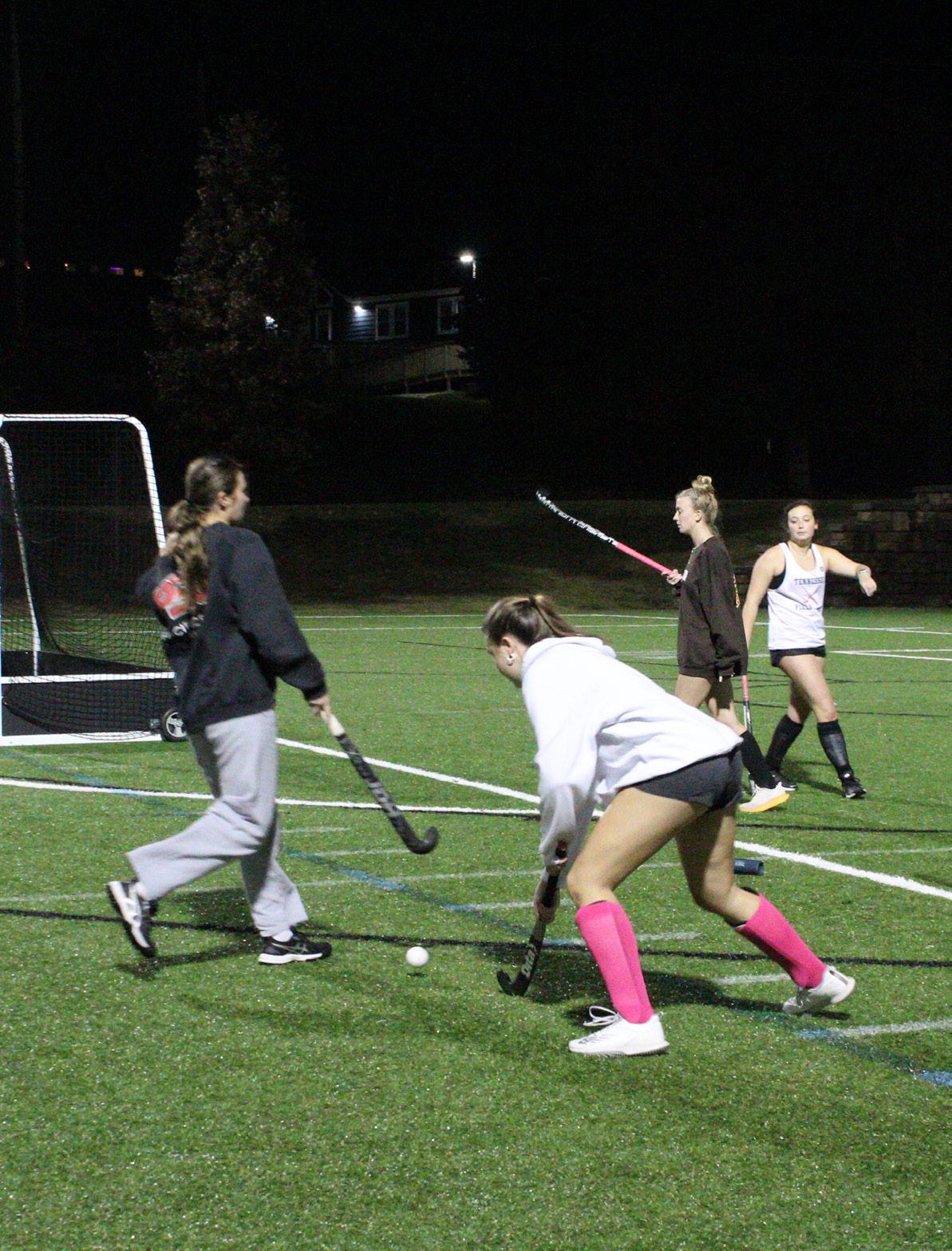

When people think of athletics, they often picture sports like football, basketball or baseball—traditionally dominated by men. However, a new era is arising as women step into leadership roles on fields and courts alike, including UT’s women’s club field hockey team.
Founded in August 2023, the field hockey club has become a vibrant space for women to express themselves. Under the leadership of Vice President Allie Baker, the club participated in its first tournament at Vanderbilt last year, finishing with a record of 1-1-2. Most recently, the team hosted a tournament Sept. 21-22, where it finished 1-3-6.
Sports are complex and demand significant commitment supported by the teamwork and closeness that define the women’s club field hockey experience.
“I usually play on the right side, which involves a lot of running,” said Lily Hague, a junior midfielder. “I get to play both offense and defense, and kind of always be in the play and that’s what I really enjoy about it.”
Hague’s inspiration for playing developed in high school. As a freshman, Hague participated in big and little sisters where she was partnered with a senior in high school (Abby) who then became a college player.
“She really inspired me to continue playing in high school and in college because she played in college,” Hague said.
When she initially heard of a club field hockey team on campus, she always remembered the passion she had for field hockey and decided to join.
As the team trains rigorously, navigates challenges and celebrates victories together, the players are not just sharpening their skills; the players are also building resilience and self-confidence. The field hockey team dominates the game with their dedication.
“It can be challenging to keep up with the play—when the ball makes it to the other end of the field, you have to get back and adjust your role,” Hague said.
From training days to impressive plays, these young women exemplify what it means to empower one another.
Hague describes the team environment as the Planet fitness slogan, “Judgement Free Zone.”
“When we face challenges, we lift each other up. If someone makes a mistake, there’s no blame—just a focus on improving together,”
“When we face challenges, we lift each other up. If someone makes a mistake, there’s no blame—just a focus on improving together,” Hague said.
While supporting one another through setbacks, the team also celebrates victories together.
“Scoring my first goal as a college student was incredible,” Hague said. “I celebrated with my best friend, Kaylee, with our little jump when one of us scored. It was a cool memory during our first tournament last year.”
Nora Racz, a sophomore on defense said when she learned about the club team on campus, she knew she had to join. Racz plays left or right defense and values her role as a first source of communication for her teammates.
“My favorite part of the team is the relationships I’ve built on the field. Team chemistry is essential, and those friendships enhance our performance,” Racz said.
A standout memory for her is receiving compliments from teammates after games: “When my teammates tell me I did a good job, it feels rewarding.” Racz said.
“Having self-confidence, as well as confidence in others is really important because it’s not a single person game,” she added.
Racz highlighted the importance of strong communication and trust in overcoming challenges. Her biggest mentor in the sport was her high school field hockey coach, Janet Baird, who would often say “don’t get mad, get better,” and she recalls those words sticking with her in her journey.
Racz and Hague both agree the team is open to beginners and welcoming to newcomers.
“It might feel intimidating at first, but don’t be afraid. The girls here are welcoming and just want to have fun together,” Racz said.
“The whole club is welcoming, so if you’re new, you’ll find support,” Hague said.
Despite her initial uncertainty, Racz quickly felt included and now serves on the executive board by helping on the social media page.
“I felt like I belonged from the start,” she said. “My advice to future players is to take the chance—don’t miss out on opportunities. College is the time to experiment.”
Their experiences are shattering stereotypes and paving the way for future young women.
“I hope we build chemistry on the field, go far in the national tournament and have a strong record this year and next,” Racz said.
“I want to see them grow into amazing women, graduate and maintain lifelong friendships,” Hague said.
The team’s journey reflects a broader cultural change, showcasing how female athletes are challenging stereotypes and reshaping perceptions of strength and capability.
To learn more about the team, check out their Instagram, @utkclubfieldhockey.
WrittenbyLilyRutherford | PhotosbyDJCampos | DesignedbyPeytonBlumenfeld
90s futurism, baby tees, flip phones and the internet-altering rise of MySpace. This is what some may think of when hearing the term “Y2K.” For others, maybe older generations, nostalgia of the era may relate to fear-inducing computer errors and technological shutdown.
Sure, both ideas had a part in the early 2000s, but what really made the Y2K era special? What was the University of Knoxville like back then and how has Knoxville itself changed since?
Jumping back to the academic year of 19992000, the University of Tennessee had a total undergraduate enrollment of 20,259. For the current academic year, the university stands at a whopping undergraduate enrollment of 30,564.
With nearly 25 years separating us from the prime of Y2K, our school has grown 10,000 students in undergraduate education. This growth has been paired with an accompanying plummet in acceptance rate and expansions in academic programs, sports and the surface area of campus.
In the early 2000s, the Cumberland Avenue Strip we all know and love was holding onto its original four lanes, only later being forced down to the current two non-turn lanes we now drive down daily.
Plenty of different restaurants and bars from those we currently know lined Cumberland, and much of it was vastly different from how most of us here have seen it.
But what was it like for someone who actually lived here during this period?
“Knoxville as a whole felt like a nice small-city, but the biggest thing of note to me at the time was a pretty derelict downtown area. No one really wanted to live downtown,” said Angela Batey, PhD and current associate director of the College of Music for Graduate Studies.
Batey arrived in Knoxville, starting as an assistant professor in the UT Department of Music, in August 1995.

Since the time of Batey’s arrival, UT’s College of Music has gained distinction as an AllSteinway School and has become the first public college of music in the SEC.
“Now, in 2024, I’m starting my 30th year at UT as an Associate Dean in the Natalie L. Haslam College of Music,” Batey said. “The growth and vibrancy of the downtown area is just remarkable. There is a real ‘vibe’ to the city and waiting lists for downtown living.”
The accuracy of what Batey mentioned is notable – there is no doubt all students in Knoxville are well acquainted with the current housing crisis facing the city.
That same truth about growth and vibrancy in Knoxville’s Y2K period can now be said for many parts of Knoxville, as well as the University of Tennessee itself.
Just like the rest of Knoxville, the University is eager to grow.
As of Fall 2024, Haslam College of Business has set a $227 million budget to support what will become a five-story education center. This shiny new building will hold the Boyd Center for Business and Economic Research and the Anderson Center for Entrepreneurship and Innovation in addition to various academic departments and programs.
Another notable step in the University’s plans for expansion is the Neyland Entertainment District.
In 1995, barely preceding the Y2K era, Neyland Stadium completed an expansion bringing its maximum capacity for the time to over 100,000. A few years later, in the depths of the era circa 2006, Neyland completed the first phase of plans for massive renovations with a price tag of $26 million.
Now, in the 2024-2025 academic year, Neyland Stadium boasts a capacity of 101,915 and has undergone various other renovations including the addition of the Stokely Family Media Center as well as upgrades to the sky boxes and broadcast center.
In the near future, plans for Neyland include a variety of assets to enhance Volunteer football gamedays. A few of these additions include a full-service hotel, retail space above the G10 parking garage, and connection of Neyland Stadium to Food City Center.
The Knoxville of Y2K compared to the Knoxville we know now are strikingly different.

Yet, with the growth of time, this city has developed into one of the best college towns in the country and only furthered its passion and spirit for The University of Tennessee. Who knows where Knoxville will be in 25 years?
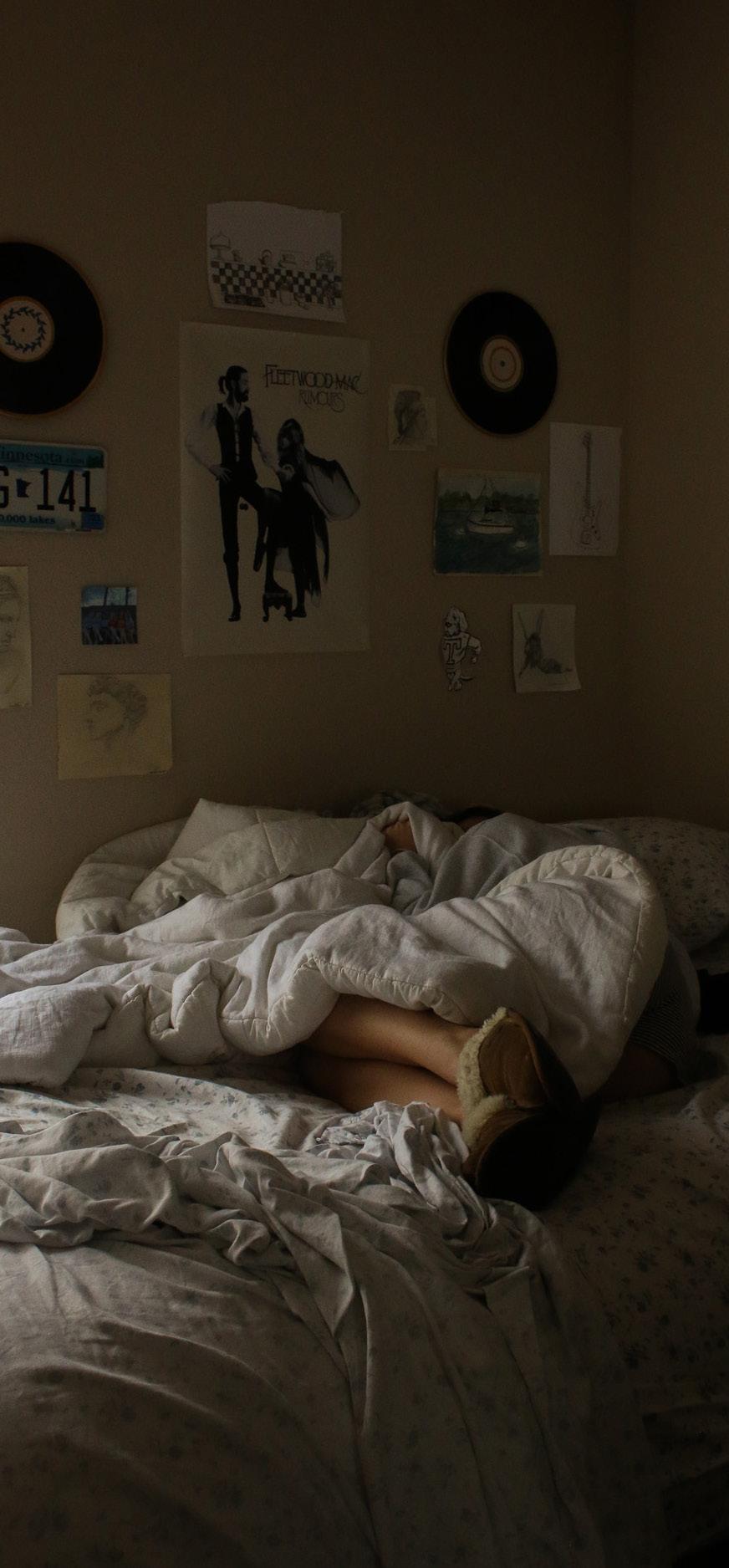
Written by Aly Fraser | Designed by Kyla Kirby
Coming out of a long, cold winter, it can be difficult to feel motivated. Spring cleaning is a popular trend to declutter and free up space, but it also can be about more than just literal cleaning. After the colder months, it can be helpful to check in with your mental health as well and “clean out” the winter blues. Spring cleaning can help you clean both literally and mentally and help you feel more prepared for the months ahead. Here are spring cleaning tips to help get organized and motivated.
Start Small
To build the habit of spring cleaning, set aside time to complete one task a day. Whether it’s cleaning that stack of dirty cups on your bedside table or folding the growing pile of clean laundry, taking just five minutes to complete a task is a great motivator to get more done later. It can also help to boost your motivation and make you feel better knowing you got something done that day.
Make Time for Yourself
To ward off the winter blues, make time towards something you enjoy doing. In the midst of homework, internships, and constantly keeping up with your inbox it’s hard to make time for yourself, but it’s important to spend time doing other things that make you happy.
According to a study by PLOS One in 2021, increased sun exposure was associated with less depression symptoms and other activities such as pursuing cognitive behavior therapy through writing gratitude lists and managing stress levels through exercise are small ways to give yourself a boost of serotonin and make time to feel good about yourself.
Cleaning out your closet is a great way to get into the habit of spring cleaning. By donating clothes, you may feel less cluttered in the space you have hibernated in since winter. Making room in your closet is a great motivator and can even lead to finding a cute outfit buried in those hangers.
Reading is proven to reduce stress and increase relaxation. One study conducted by the University of Sussex found that reading six minutes could reduce stress levels by 68%.
So many people lose their attention span due to constantly being on social media, especially when finding things to do outside is hard. Reading can help spark your imagination and give you a new hobby to help you to unplug and relax.
Creating a schedule each day can help keep a structured routine. By setting a time to wake up every day and create a list of tasks to get done, creating a daily “to-do” list can relieve stress by getting it all down on paper and boost productivity by giving you something to physically check off with each accomplishment.
If you always have a drawer full of random items or have a hard time getting rid of things, try to spruce up your environment by organizing. Color coding your closet or using desk organizers make the environment around you feel less cluttered and organization can be used as a productive habit.
Having a self-care day is a great way to feel better. Putting on a face mask or taking a long shower can easily put yourself in better spirits by focusing on yourself.
Discovering something new can help to set your sights on the future if you feel stuck in a rut. Finding a new song, show or book you had never heard of before is a great way to get into higher spirits.
Whether it’s organization, self-care, or having a productive day that helps motivate you, it’s important to focus on yourself. Spring cleaning is a great way to help yourself physically and mentally get out of the harsh months of winter and look forward to what’s to come in the spring.

Written by Ava Franzoy | Designed by Riley Doyle | Photos by Joe Mitchell | Model: Madison Le
I’ll never forget when I received my very first phone in second grade — a bedazzled bright pink flip phone. It had three contacts: mom, dad and my best friend Mia. It was ready to go with the entire Taylor Swift debut album downloaded. I couldn’t yet surf the web; my parents had some sort of jailbreak on it. I could not text or call freely since this was before unlimited data. Still, walking into school with my shiny new phone made me feel like the coolest kid in class.
In fifth grade, the iPhone four had been released, and it was a good-bye flip phone, hello Apple products. Apple quickly became synonymous with my childhood and embodied what I thought it meant to be cool.
By middle school, everyone I knew had a phone. We made Musical.ly videos together, had secret Instagram accounts dedicated to shipping couples and overused the dog filter on Snapchat. By seventh grade, the iPhone 5c had been released. While I reverted to the days of having a bright pink phone, things had changed. My contact list had expanded, I surfed the web freely and Taylor Swift’s debut album had been replaced by Taylor Swift’s “Red” album.
In high school, it was no longer “cool” to have a phone, it was a societal expectation. The world was at our fingertips 24/7, and concerns about our digital footprints and phone addictions began to surface from the elders. As a result, we made private stories, secret accounts and fought back with online discourse using apps like Twitter. I no longer cared about what my phone looked like, although a loyal Apple user, I had a cracked screen for nearly a year.
In college, having a phone had become like having a third limb — if it wasn’t attached to me, something was seriously wrong. During my first few years at college, a new form of technologcal dependency developed through artificial intelligence. Otherwise known as a college student’s best friend, AI can do everything from solving math equations to writing mediocre breakup texts. Tasks that once required time and effort are now instantaneous and accessible from the technology that raised us: our cell phones.
“Ai
“AI is the new kid on the block and it is growing at an exponential rate…by 2034 it may expand beyond our phones,” said Tekobo Dongmo, a member of UT’s machine learning club.
From flip-phones to AI, technology has come a long way in the last twenty years. While the little flip phone made me feel like the coolest kid in class, the later phoneswere less about status and more about staying connected, and now, with AI, my phone feels like a part of me.

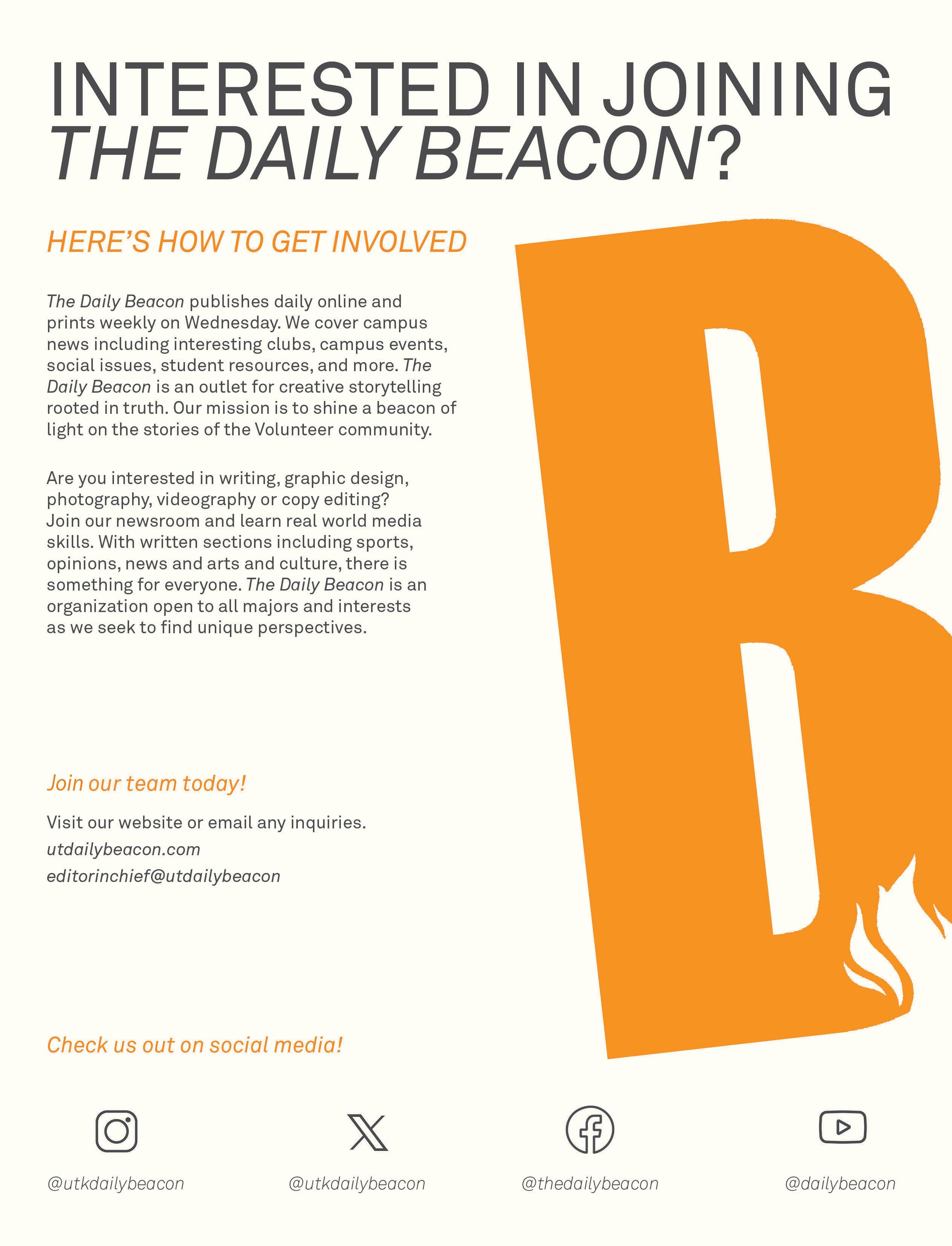



Each month has a unique role to raise awareness for a social issue. Whether that be pride month, Black history month or national anti-boredom month, these months serve to commemorate societal progress and challenges as well as remind us of room for growth.
January: International Quality of Life Month
Quality of life is an esoteric concept silently alluded to by most every other month on this list. Why do we have mental health awareness month? To ensure a high quality of life. Why do we have sexual assault awareness month? To protect quality of life. Why do we have human rights month? To preserve quality of life. On account of that, celebration and upholding this month is best accomplished through keeping at being a good person cognizant of and dedicated to improving the world’s issues.
February: Black History Month
Black History Month, which was founded by Carter G. Woodson in 1976 during the civil rights movement, is celebrating the achievements and struggles of African Americans in the past and the present. Although the struggles of Black americans date back to the start of this nation, this makes Black History Month one of the newest editions to commemorate months.
At UTK, Black History Month is celebrated with events, including art exhibitions, a film showing of “I Wanna Dance with Somebody” and a fashion show. Often times, UTK’s events for Black History Month have a goal of education on issues which are systemically undercovered.
March: Women’s History Month/Gender Equality Month
Containing National Women’s day on March 8, Women’s history month celebrates Women’s achievements. These steps of progress and innovation have been often overlooked or obfuscated in our herstory.
Though this month is typically dubbed Women’s History Month, it is equally valid to also call March Gender Equality Month. Referring to this month with an acknowledgment of gender equality allows a direct address of the central theme of women’s rights. In addition, a simultaneous celebration allows acknowledgement of the cultural role and history of gender diverse individuals. Like all other months, our progress continues daily as gender issues appear in nearly all social problems.
April: Sexual Assault Awareness Month
Unlike other commemorative months, Sexual Assault Awareness Month uses the word “awareness,” due to a deficit in recognizing sexual assault in the first place. Sexual assault will best be prevented through safety as well as acknowledgment. We need sexual assault’s multitude of contributing factors to be addressed directly in order to prevent active harm that applies to many students as we face unique problems such as party culture, drug culture and hazing.
May: Mental Health Awareness Month
Mental Health Awareness has direct implications on the lives of students with the stress from classes and adjusting to a new form of life, potentially away from home. Thankfully, mental health issues are becoming gradually destigmatized as it becomes normal to open up about our inner battles.
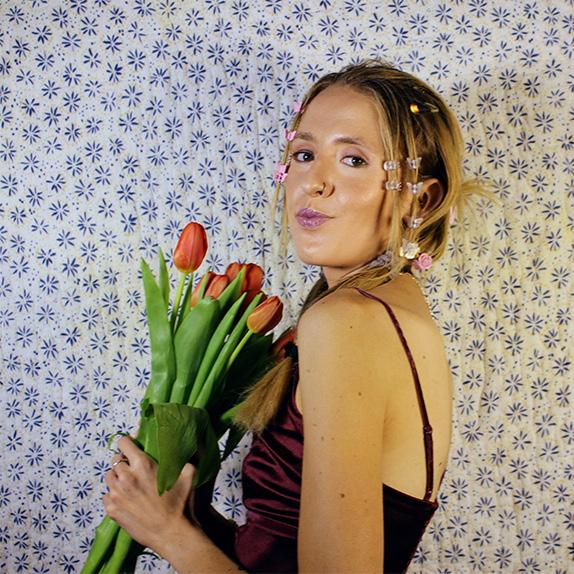
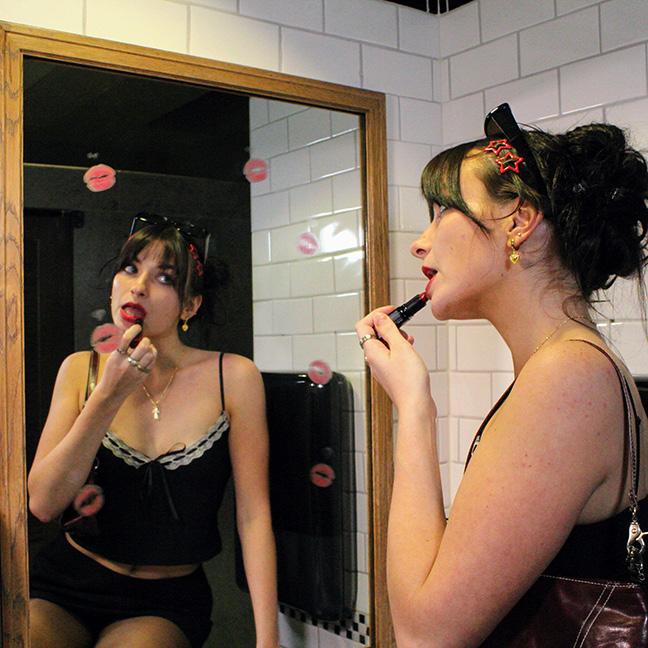

“Anxiety is the most commonly reported mental health concern among college students and in the population as a whole,” said Nicole Saylor, the director of the Student Counseling Center.
This is in addition to common concerns Saylor cited such as depression, suicidal thoughts, unresolved past trauma, personal identity, relationship issues and non-suicidal self harm. Thankfully, the Student Counseling Center provides both individual and group therapy to help alleviate these issues.
“The first pride was a riot,” Bee Bussell, an Alumna, said. Bussell was referring to the Stonewall rebellion, which took place on June 28, 1969. Pride month commemorates Stonewall, a riot created by a police raid of the Stonewall Inn. Today, Pride is celebrated for all LGBTQ+ individuals. June’s place in the middle of summer can lead it to being absent from direct student involvement, but luckily most major cities host Pride parades, including Knoxville.
July: National Anti-Boredom Month
July’s place in the middle of our summer break and its relatively little student work is exactly what warrants its holiday: National Boredom Month. Hopefully this magazine helps promote an anti-boredom cause. If your boredom is limited and short-term, perhaps it will be cured. However, more troubling and persistent boredom may need a deeper plan. According to a survey of 715 university students published in the International Journal of Environmental Research and Public Health, boredom is negatively correlated with social support, a presence of the meaning of life and cognitive flexibility. That is to say, if you are looking to embrace the spirit of anti-boredom, you may want to search for the meaning of life.
August: Transgender History Month
This month has a unique role of not being acknowledged by UT despite how pressing transphobic attitudes are for many students. UT also has not officially acknowledged the Transgender Day of Remembrance, which happens on November 20th. Transgender and gender diverse people have often had their history marginalized by dominant cultural attitudes which exclude them in public and private life. Transgender History Month has one key purpose of countering the myth that transgender history began in the late 20th century. In reality, transgender history involves erasure of both medical information regarding transitioning and cultural knowledge.
This month is split between September and October, starting on Sept. 15 and ending on Oct. 15. The unconventional beginning and ending of National Hispanic Heritage month owes itself partially to many Latin American countries gaining independence within this time frame. This month focuses on the active and historic contributions made by Latino Americans. At UT, this month was celebrated through Vol Avenida, a festive event hosted by The Office of Multicultural Student Life as well as the Latin American Student Organization.
This month should serve to raise awareness of the underrepresentation and lack of accommodation and acceptance that disabled people encounter in daily life. With the knowledge that we can gain from disability awareness, we can improve the management and acceptance of disabilities. But being aware of disabilities is often a problem that goes much deeper onto a conceptual level. It’s also important to remember invisible disabilities. Conceptions of disabilities are often born out of a stigma that all disabilities either affect somebody’s health, cognitive abilities or affect their mobility. Many disabilities are not noticeable without conversation or without knowledge of how disabilities affect people. Of course, it’s still a person’s private decision on whether or not they wish to mention their disabilities. These conditions underlooked as disabilities in nature such as depression, anxiety and eating disorders, which can often be marked off as a mental health issue (which they are) without consideration of how they fit the definition of disability in that they impair ways of life.
National Native American Heritage Month has been celebrated since 1916 in New York, but was elevated to a national level only in 1990. Native American heritage and history has been not only obscured but also erased from common American history. Given that the economic and cultural effects of discrimination are still lesser known and lesser taught, a heritage month is an excellent way to raise awareness of the challenges faced by Native Americans. As a society, we must analyze past and present human rights discriminations in order for our society to flourish.
Human rights are protections that all humans are entitled to. The need for human rights underpins countless contemporary global and domestic issues. Human rights can also be culturally dependent. For instance, equal protection under the law is a human right in modern society given entrustment of nations to ensure human rights. This makes human rights a highly politicized issue when nations and corporations do not protect human rights. The issue of human rights will remind us that any remembrance month has its continued modern day struggles.
Though each month specializes in raising awareness to lesser known issues of prolific problems, this does not mean that the problems of our world are confined to one month. Rather, each month which deserves awareness with a month deserves attention with a year as well.
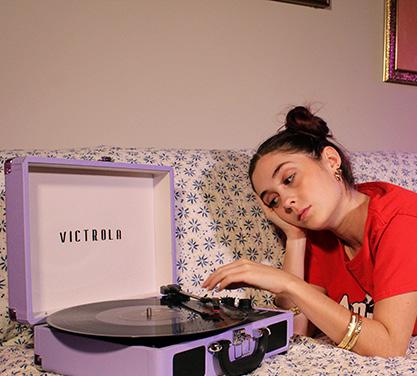

WrittenbyLilah
|
For many young women in college, there is a pressure to get a new going out top for every party or a new swimsuit for each day of spring break. From Shein hauls on TikTok to constant personalized ads on Instagram, the pressure to shop is real.
Though these small purchases may not seem like a big deal, they contribute to fast fashion.
“Fast fashion is clothing that is mass manufactured for very low prices and resold for a higher price while not being made very sustainably. It is bad because of the immense amount of clothing that already exists on our earth,” said Steven Lopez, a senior and leader of UT’s Sustainable Fashion Club.
As Earth Day approaches, environmental awareness is brought up more and more. Earth Day is especially important for college students because it was originally a student movement started by senator Gaylord Nelson and young activist Denis Hayes in 1970.
“They choose April 22, a weekday falling between spring break and final exams, to maximize the greatest student participation,” according to the Earth Day Organization.
These student protests became a nationwide movement that led to environmentally friendly laws being passed.
In the 70s, activists were worried about air pollution. Today, environmental activists have a new problem to face with the rise of fast fashion.
Lopez started his club in order to promote creativity and sustainability for students interested in fashion and vintage clothing. The club hosts various events, including vintage sales and meetings that give tips about selling your old clothes online.
“Our club has worked together to demonstrate to students how second hand clothing can be of high quality, in style and more affordable than fast
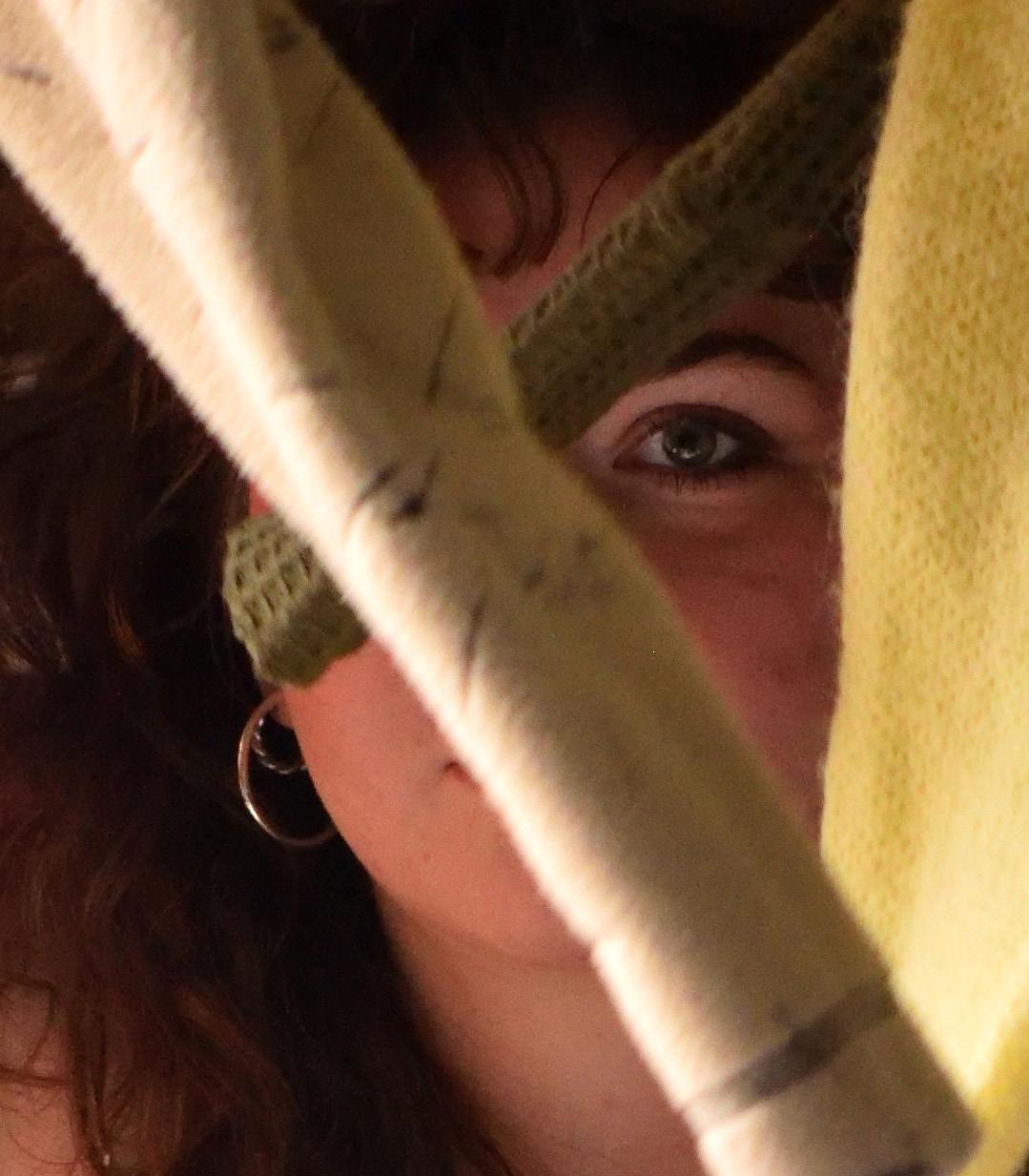
fashion. We also have sourced clothing in landfills, thrift stores and garage sales to give them a new life on our campus,” Lopez said.
Attending the sustainable fashion club’s clothing sales is one of many ways that students can prioritize the environment in their day to day lives. Carrying a reusable water bottle and recycling are small changes with major impacts, and so is avoiding the “add to cart” button in an era

In order to fight fast fashion, students can visit thrift stores or the Free Store on 22nd Street. The Free Store is open from 10 a.m. to 3 p.m. on weekdays, and they also do various pop up events around campus. Not only can people shop there when they need a wardrobe refresh, but they can also donate old clothes to the Free Store in order to help fellow students.
Another way to find an outfit for that themed party is by swapping clothes with friends. Instead of going to buy something new, ask around to see if you can borrow that item from a friend.

As Earth Day grows closer, try to implement these tips to help keep clothes out of landfills. Though it is great to thrift when possible, remember that in a capitalist society it is impossible to be perfectly eco-friendly. The whole point of fast fashion is that it’s easy and accessible, especially for broke college kids. Don’t feel bad for buying that new shirt, but try to get as much use out of that item as possible.
From thrifting with your friends to attending a sustainable fashion club meeting when you have a free Thursday, there are endless ways to treat every day like it’s Earth Day.



Advertising Public Relations
Advertising & Public Relations
Social Media Analytics
Study Abroad Rome, Italy
Siena, Italy
Student Organizations
AdClub
PRSSA Student Networking Trips
New York City
Los Angeles Nashville
Washington, D.C.
Atlanta ...and more!



Work in settings such as: Agencies
Entertainment Sports Healthcare Media Relations Non-Profits
Politics Government SCAN FOR MORE INFORMATION

Written by Ava Franzoy, Aly Fraser, Carmen Rivera and Charlotte Roselin | Designed by Natalie Neal
Does “opposities attract” actually apply to romantic relationships?
How do you think social media affects modern-day relationships?
What are tips to balance a relationship with friendships, academics and everything else?
What defines a healthy relationship?

It feels like opposites attract is a romantic image displayed in books and movies. The hot guy goes for the nerdy girl, or the nerdy guy pulls the hot girl, but besides their stereotypes, what makes a couple opposite from one another or does this image even exist? One of my friends has dated this guy for a bit of time and I’ve had people say, “I didn’t see that coming.” My friend and her now boyfriend seemed completely opposite. Different friends, hobbies, and lives altogether but they seemed to fit better together than many other relationships I’ve seen. They had similar music tastes, interests in food, all their friends seemed to mix well. The couple people didn’t see coming fit perfectly together. I think the idea that opposites attract can definitely apply to relationships, including people with vastly different personalities and looks, it’s just about how the two people mix together.
Social media profoundly influences modern relationships by fostering a culture of comparison. As we scroll through our feeds, it’s easy to believe that what we see others have is what we should aspire to achieve. This fixation can steal our joy, leading us to forget that everyone’s experience is unique. It’s crucial to remember that social media often presents a curated fantasy rather than reality. While relationships may appear perfect online, they often come with struggles. The pressure to meet these perceived standards can lead to disappointment in our own partnerships, overshadowing appreciation for our unique experiences. Furthermore, constant comparison can strain relationships, making one partner feel inadequate or pressured to conform. Open communication about these feelings is vital, as it helps us recognize that each relationship has its own dynamics. Ultimately, by focusing on genuine connections and valuing the qualities that make every relationship special, we can counteract social media’s negative effects and cultivate healthier, more fulfilling partnerships. We must remember that true fulfillment in relationships comes from authenticity and mutual respect, not from the curated images we see online.
Sometimes it’s hard to balance a relationship with everything else, especially if you’re considered, “in the honeymoon phase”. Maybe your partner is all you can think about, talk about, and who you spend all your time with. Having been one of those people, it’s so easy to revolve your life around your partner, because they make you happy. The truth is if you break up with someone you were fairly attached to, you realize how much you were missing out on outside of your relationship. You need to remember that there are multiple things that define happiness, and a partner should not be the only thing that makes you feel good. To keep balance, take time away from your partner. Make time for friends, family, and the hobbies you like to do. Communicate why this is important with your partner and try to keep that bit of distance consistent throughout the relationship. Balancing time with someone you’re dating is one of the most important factors that keeps a relationship healthy.
Although a healthy relationship doesn’t include a straightforward definition, there are a couple of signs you should look for. The first is that you are both happy and comfortable with each other. Compassion is a huge factor in a relationship and should be at the forefront. If you aren’t there for one another, it can take a toll on mental health, which should never be the case. If you encounter rocky times, work through it–not around it. No relationship is perfect. And you will find times in need of assurance and sympathy. This will further the growth as individuals and as a couple. Be there, show up, and support each other! It will only bolster the solidity of your relationship and create an embracing, communicative, and trustworthy environment.
How do I introduce my significant other to my family members?
MENU
How can you balance independence with togetherness in a relationship without becoming dependent on one another?
Carmen
How can I support my S/O personal growth and ambitions as well as my own?
MENU
What are ways to make long distance easier?
The fear of inappropriate dad jokes, a mediocre casserole dish and awkward conversation fills your thoughts as you and your significant other pull into your driveway for the first time. Or maybe it’s the baby books your mother has been dying to pull out, and the “Do you think they know we hooked up?” question that burns in your mind. Although a natural part of the relationship cycle, introducing someone to the family for the first time is scary, and that’s okay! Unfortunately, there’s no “right” way to introduce your significant other to your family; however, meeting in a public setting may allow you to avoid unnecessary stressors like casseroles and baby books. My best advice for you is to pick a time and place that feels natural. Be yourself, stand your ground and the rest should fall into place.
MENU
How should conflict be handled during a disagreement with you partner?
MENU
I’ve always held some dependence on people without realizing it. Not only in relationships, but with my friends. I realized I depended on people to make me feel content with myself and it’s important to know if you have a similar characteristic before jumping into a relationship. Claiming independence within a relationship is one the most important factors. When you and your partner have separate hobbies, friends, or even goals, it shows you have confidence within yourself which can reduce the toxic issues of jealousy and insecurity that exist with lots of couples. One way to feel less dependent on people is taking time for yourself. It’s a great thing to love and care for your partner, but it’s more important to put yourself first and keep some separation to benefit each other.
Supporting your significant other’s personal growth and dreams is essential, but nurturing your own ambitions is equally important. Striking a balance between celebrating each other’s successes and learning from setbacks is key to a thriving relationship. Embracing a team player mentality—where both partners uplift and inspire one another—creates a strong foundation. Recognizing that circumstances can change is crucial. Personal growth often requires individual pursuits, and fostering your own ambitions empowers both you and your partner. To support one another effectively, set aside time for regular reflection to discuss your goals and aspirations. This practice keeps you connected and encourages the exchange of insights and constructive feedback. Encouraging independence is also vital. Respect each other’s need for personal space and exploration in activities outside the relationship. Creating a supportive environment means being a listener and offering encouragement, reinforcing that you’re in this together. Share your experiences and lessons learned to navigate challenges more effectively. Finally, celebrate milestones—big or small—to strengthen your bond and motivate each other. A thriving relationship is built on mutual support, respect, and the understanding that both partners can flourish individually while growing together. By nurturing your ambitions alongside your partner’s, you enrich each other’s lives and deepen your connection.
Long-distance relationships can be hard; there’s no doubt about it. It’s important to keep an open heart and mind when trying to alleviate some of the challenges of this situation. We know that “communication is key,” but it is critical when in two separate locations. Don’t be that couple that forgets how to make time and talk to one another. If you find yourself in the chaos of work or school, plan something to look forward to. Get creative! Plan a movie night, a cooking FaceTime, a virtual walk, an online game–opportunities are endless. The key is to affirm your connection through communication, effort, and excitement. Once you reconnect in person, it will feel like no time has passed, making up for the time spent away.
I have a long-distance best friend who likes to call and vent about arguments with her boyfriend. Usually before she starts her rampage, she hesitates and says, “it was something so small that escalated so quickly.” The best way to handle conflict with your partner, whether it’s a small thing that’s being bickered over or a huge buildup of emotions, it’s important to address what the actual problem was. Even if it’s a small problem compared to the variety of extreme arguments that could take place, it’s best to address it before it becomes a larger issue. It’s important to stay on topic when disagreeing, because getting off track leads to endless possibilities of things to be mad over. When an argument like this occurs, it’s important to address the issue calmly as possible and to give your significant other space. If your partner tries to understand where you’re coming from, it can be a sign of a healthy relationship.
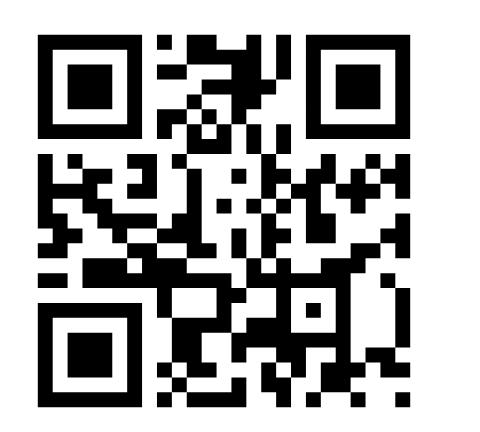
Check out our website!


